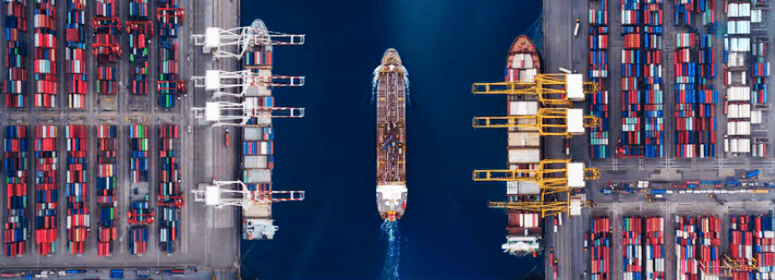- [email protected]
- Sat - Wed: 8:00 - 16:00 - Thu: 8:00 - 12:00

Basic Shipping Knowledge
The cargoes carried on sea fall into several categories, each requiring the usage of specialized ships. The two main categories are GENERAL and BULK cargo. General cargo is unitized (carried in defined load units) while bulk cargo is loose (carried in any quantity). Please review Liner Terms for more details on the scope of responsibilities and cost distribution when shipping such cargoes.
Basic Shipping Knowledge
The cargoes carried on sea fall into several categories, each requiring the usage of specialized ships. The two main categories are GENERAL and BULK cargo. General cargo is unitized (carried in defined load units) while bulk cargo is loose (carried in any quantity). Please review Liner Terms for more details on the scope of responsibilities and cost distribution when shipping such cargoes.

General cargo can be divided into three categories:
- Break Bulk: Cargo which is carried in drums, bags, pallets, or boxes. Ships carrying such cargo are typically geared.
- Neo Bulk: Cargo with each pre-packaged unit countable such as lumber (bundles), paper (rolls), steel, and vehicles.
- Containerized: The growth of containerized shipping required the creation of a new general cargo category where the cargo is being carried in ISO container load units.
Bulk cargo can be divided into two categories:
- Liquid bulk: The majority of the liquid bulk being carried is petroleum LNG (Liquefied Natural Gas). Liquid bulk ships are commonly referred to as tankers.
- Dry Bulk: Includes a wide variety of materials such as coal, iron ore, grains bauxite, and sand.
General Information
Freight Costs
These are the costs incurred in moving goods, by whatever means, from place A to Place B under the terms of carriage contract or Bill of Lading.
In addition to transport costs, Freight Costs may include such elements as packing, documentation, loading, unloading and transport insurance.
Main elements effective on Freight Costs include:
- Freight (Basic Ocean Freight): the amount of money which is to be paid for the carriage of goods, payable either in advance or upon delivery.
- Surcharge: An additional charge added to the basic ocean freight.
- Local Charges: Costs associated with handling and clearing the goods at the ports of loading and discharging.


How to calculate freight?
How does a shipping company such as FARMAD calculate the level of freight to charge its customers for transportation services? The answer is, of course, “it depends …”.
Since we usually ship 20’ and 40’ containers, you may assume that, in essence, a 40’ is double the price of a 20’ container because it takes twice as much space on board a vessel – but this is not how it works, actually. From our viewpoint lifting a 20’ or a 40’ is, in many regards, the same.
There are some other factors affecting the freight, such as:
- Value of the commodity – as a general rule (with some occasional exceptions), ocean freight rates are likely to be more expensive for higher value cargoes, considering liabilities and insurance concerns. Therefore, a container of high-tech electronic products is likely to cost more to ship than a container of scrap rubbers.
- Weight – Ships spend energy (fuel) to move a mass (e.g. container). Therefore, it costs more to move a heavier box. Just because a 40’ container is double the length of a 20’, it cannot bear double the weight. The container needs to have double strength for that to be true. In fact, the longer length of a 40’ means that it can bear slightly less weight (26,600 kg) than a 20’ (up to 28,200 kg). As a result, heavier cargoes are suitable to be shipped in 20’ containers, while 40’ units are used for more lightweight commodities.
CHARGEABLE WEIGHT IN LCL SHIPMENTS
- Special equipment needed – some cargoes by nature cannot be shipped in a ‘standard’-dry – or general-purpose (GP) – container (DC). They might need special equipment such as an Open-top container (OT), Flat-rack (FR), Platform (PL), Tank container (Tank-tainer), Livestock Container, or Refrigerated container (RF/Reefers), etc. Such requirements usually cause extra freight costs. Moreover, with reefers, the carrier has a more direct responsibility towards the cargo; the containers must be monitored regularly, in optimum condition at all times and of course, they consume power during transit. Meanwhile, where Flat-racks or Platforms are used – typically for out-of-gauge cargo – the ocean freight will be negotiated each time based on the particulars of that ship/voyage.
- Availability of vessels in the related trade zone – Normally in a free market, where there is a heavy competition between carriers in a specific trade zone/lane, ocean freight rates tend to be lower. Naturally, when the volume of cargo exceeds the total capacity of vessels in the same trade zone, the tariff tends to be higher.
What are surcharges?
Commonly, ocean carriers charge an ocean freight, plus two surcharges: the Terminal Handling Charge (THC) at the loading port and the THC at the discharging port. The THC is the sum ports charge carriers operate at their facilities. Usually, origin port THC and destination port THC are to be paid by shipper and consignee, respectively.
Some other potential surcharges:
- Currency Adjustment Factor (CAF) – When the freight is payable in foreign currency and that currency is subject to major exchange rate fluctuations, the shipping company sometimes levies a currency surcharge or CAF (Currency Adjustment Factor) so as to compensate for those exchange rate risks. It is often charged with the basic sea freight as a percentage.
Bunker Adjustment Factor (BAF) – Obviously fuel price is a significant factor in ocean transport (bunker is the term for fuel used by merchant vessels). Carriers have to put in place a Bunker Contribution, which is an adjustment applied to offset the effect of fluctuations in the cost of bunker fuels.
Local Charges
These are charges in loading and/or discharging ports (countries) that are to be collected from the shipper or consignee. Local charges include but not limited to the storage fees, local insurance premiums, customs duties, and VAT.
The Booking
When we negotiate a tariff with you, our dear customer, and you agree with our rates and conditions, you make a booking. But what does this actually mean and what happens next?
A booking is a reservation, just as you make one for a restaurant table or an airplane flight. It is an understood or implied agreement that you will provide your merchandise for transport at the price which was agreed.
We reserve a space for the cargo on a vessel (a container slot) and we reserve the empty container itself at our terminal for your agent/broker to come and pick-up.
We collect some basic details and will advise you of the booking number. That reference and the trucking company and driver’s name will be transferred to our terminal. A terminal is a secured area to keep our containers and our stevedores will only let an agent/trucker inside if he has a valid release letter including booking number corresponding to his company name.


Our Services
Equipment applicable charges and potential costs
When FARMAD is appointed to transport your cargo from an origin to a destination an important part of this agreement is, obviously, the provision of the container itself.
The period of time you have to utilize the allocated equipment is usually defined in the terms of sale. A period of ‘Free Time’ is defined within this timeframe. The last thing you need is to receive an unexpected invoice for extra charges, so we recommend you to review the below terms at your earliest convenience:
- Free Time: The number of days the receiver is allocated after a container is discharged from the vessel to do the reasonable customs clearance and arrange for loading out of local customs. The ‘Free Time’ can of course vary from port to port. Therefore, please make sure you ask us for more information on each case.
When the container remains in your possession beyond the ‘Free Time’ allocation, you will be subjected to additional charges during the exceeding period – these charges are called either ‘demurrage’ and ‘detention’.
- Demurrage: This is the additional charge for exceeding the ‘Free Time’ at the discharging port terminal and is accumulated on a daily basis.
- Detention: This charge is applied to customers that hold equipment outside the terminal longer than the agreed ‘Free Time’. It is accumulated daily until the container is returned to our terminal.
Terminals and depots also have the interest to free up their spaces and bill a corresponding ‘storage fee’ or ‘quay rent’ charge.
As with demurrage, the port will define what is determined to be a reasonable period of time for the container to be kept or stored in their facility. Any time beyond that risks incurring a charge. These charges vary considerably from port to port and between imports and exports, so take the time to familiarize yourself with the port-specific charges relevant to your cargo. Of course, FARMAD advisory team will be available to assist you with this.
Returning cost
When you appoint us to carry your import cargo from any origin worldwide to Iranian ports, part of the agreement includes returning our empty container to the agreed location. Usually, this is the depot advised by our container control department in the ‘Delivery Order’ or through other means. However, the container can be brought back to another depot other than what originally advised, following a new arrangement between you and FARMAD. The overall concern is to reduce the ‘returning cost’ applied to the empty containers.
Some Useful Terms:
- Lump-sum – This is an agreed sum of money, which is paid in one full settlement incorporating the ocean freight and all applicable surcharges. This term is often used in connection with charter parties. A freight can either be broken down into Ocean Freight + THC + CAF + BAF + EIS, WRS, etc.., or simply a lump-sum incorporating all the elements into one simple figure.
- Minimum charge – This is the lowest amount which applies to the transport of a consignment, irrespective of weight or volume. This charge mostly applies to break-bulk cargo.
- Volume contracts – Like most competitive industries, it is possible in international shipping to reduce rates in return for a commitment to provide a larger volume of business. We always welcome discussions about the potential of a contracted attractive level of sea freight based on shipping a certain volume of containers during a specified period of time. Get in touch with us for further details.
- Incoterms – a widely used terms of sale, are a set of 11 internationally recognized rules which define the responsibilities of sellers and buyers. Incoterms specifies who is responsible for paying for and managing the shipment, insurance, documentation, customs clearance, and other logistical activities.